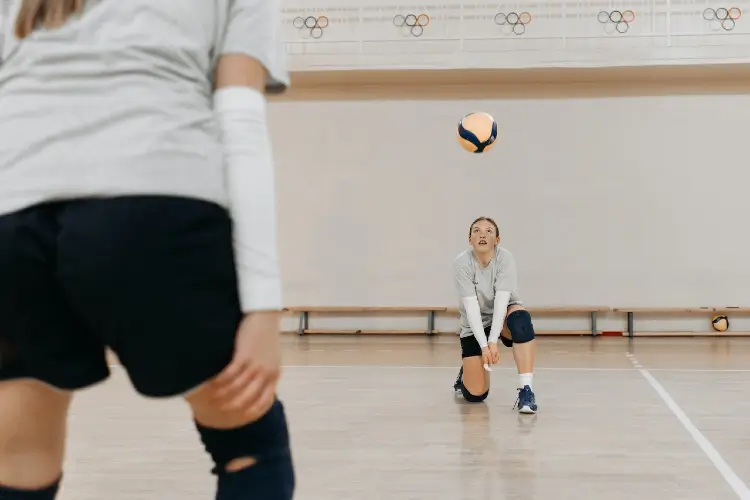Last Updated: January 12, 2024
Players who work on their volleyball passing skills are a great asset to a team. There’s no question that they can help the team score more points. After all, passers make first contact with the ball when it comes over the net.
Upon contact with the ball, passers attempt to make a precise pass to the setter, which literally sets the tone for the game because it influences the team’s ability to create scoring opportunities.
If a team cannot pass properly, the team will fail to hit well because all the balls leading to the attacker will be off. The accurate passes from the strong passers make it easier for the setter and hitters to perform their roles effectively.
Honestly, teams with talented passers are hard to beat on any given day. Their role is vital to plan an effective attack. Therefore, a team hardly ever replaces a good passer.
How to Improve Your Volleyball Passing Game

Here are the seven key steps to elevate your passing game in volleyball. It all starts with a proper mindset.
1. Have a positive mindset
A surefire way to improve your passing skills is to do the drills when the coach tells you to. As a player, you can’t afford to look at volleyball drills as a boring chore. Instead, you should take great interest in the drills, which will help you focus better. Consequently, your volleyball passing skills will improve. So, have the mindset of approaching your practice sessions and competitions with positive energy. Your team should get charged just by looking at you.
When focused on delivering good passes, know that not all of them will be great. So, don’t dwell on the mistakes. Instead, focus on the game ahead of you. At the same time, keep learning from past passing mistakes to get better balls to your setter.
Improvement will take time. So, be patient, or you will find it difficult to remain positive. A positive mindset will also let you absorb new information easily, allowing you to adapt to the changes quickly.
2. Focus on the ball early
If you start tracking the ball once it crosses the net, you are late. Your eyes should be hooked to the ball. You should visually track the ball as it leaves the server’s hands and crosses to your side of the net.
Keeping your eyes on it early will give you an early indication of the serve, allowing you to make necessary adjustments in your platform and footwork to get into the perfect position to pass the ball accurately. Basically, you improve your chances of reacting appropriately by always keeping your eyes on the incoming ball.
Keep in mind that volleyball is a fast-paced game. There is little room for errors. Quick reactions are a must to minimize errors in the game. By keeping your eyes on the ball early, you can remain fully focused, allowing you to react quickly by better judging the ball’s speed, direction, and trajectory. This is particularly helpful for passing the ball precisely when opponents use more finesse-based attacking strategies to score points.
3. Move your feet first and not your arms
Your feet should be guiding you first and not your arms. Using your legs, you can cover a lot of ground quickly, which is essential for receiving the ball in time. Try to get your body behind the ball instead of reaching out to it with your arms. This means you must quickly anticipate the ball’s direction as it crosses the net to position your body well for a successful pass. When you use proper footwork, your game improves instantly by a few notches.
Of course, volleyball is a full-body sport. So, the whole body will work in conjunction in every aspect of the game. However, you should not rely too much on your arms when serving, passing, or attacking the ball. By moving your feet first, you will be able to position your body relative to the ball, allowing you to set yourself up for a well-placed pass. When you constantly move your feet first, you will see fewer misdirected passes.
Also, make sure to use the power of your legs and hips to pass the ball and not just your arms. The use of the lower body will help you generate a lot of force, which can be extremely helpful for hard-hitting attacks. At the same time, be light on your feet, which will let you cover a lot of ground quickly. The light footwork will also help you switch quickly between offense and defense. Agility is very important to make effective passes consistently.
4. Master the platform technique
You cannot be a good passer unless you master the platform technique. Right from the hand positioning to the forearm angle, you should get skilled at using your upper limbs efficiently to provide a strong, stable, and controlled surface for the ball to land on. You should practice to keep your wrists firm. Your hands must be close to each other with your thumbs pointing down.
When your hands connect with the volleyball, your forearms must be parallel to the floor. For better control and efficiency when passing the ball, keep the forearm height above your waist. Moreover, connect with the ball at the center of your platform. This way it will rebound with greater predictability. Subsequently, it will reach the intended destination accurately.
5. Stop before you pass
You can’t be moving and passing at the same time. Your feet must be in a balanced position first. The room for errors increases if we don’t stop ourselves, at least momentarily, before passing the ball. By stopping before the pass, we can control the ball better. It also minimizes the risk of bumping into a teammate. So, it’s important to come to a complete halt before attempting to receive or pass the ball.
Seasoned volleyball coaches often point out that stopping also helps with better decision-making during the game. It allows one to quickly assess the situation and make far more informed decisions than usual. It gives passers slightly more time to react to the speed, spin, and direction of the incoming ball, which is essential for accurate passing.
Players who have mastered the art of stopping and passing consistently provide clean and controlled passes, which is vital for scoring points.
6. Communicate better
Proper communication while receiving the serve and passing the ball is vital. Good communication will not only enhance one’s passing efficiency but will also improve team coordination, leading to better team performance. You can communicate by calling out someone’s name or by telling everyone what kind of serve it is so that everyone stays prepared for their respective role. The more you communicate, the more your team players can be prepared to react.
Non-verbal clues, such as eye movements or hand signals, can also be used for communication. The non-verbal clues can help you communicate faster with others. Your team members will understand your indications faster, allowing them to make rapid decisions in real time. After all, communication between the setter and passer is vital for setting up fruitful offensive plays.
7. Toss catch drill
Top coaches commonly use the toss catch drill to work on someone’s passing ability, whether it’s a beginner or an experienced player. It is easy to perform. To initiate the drill, you will make a person stand a few feet apart from you in a suitable practice area. Your partner will be responsible for catching the ball and returning it to you to help you practice passing skills. Once your partner tosses the ball, you should aim to make accurate passes. The roles can be reversed if your partner wants to hone his passing skills.
If you don’t have a partner, you can practice this individually with the help of a wall. You will simply toss the ball against the wall using your wrists and fingertips to manage the height and direction of the toss. Once the ball rebounds from the wall, you will quickly position yourself to receive the ball and then toss it back to the wall. Like you would do when practicing with a partner, aim to return the ball accurately.
You can make the drill challenging by increasing the distance between you and the wall or between you and the partner involved. You can also vary the speed and height of the ball to practice different game situations. As you improve, you can progress to a more advanced variation of this drill. You can ask your partner to send the ball in different directions and heights to practice imperfect passes.
As well as this particular drill, you should also practice other drills for improving volleyball receiving to become a better passer.
Conclusion
It takes time to improve passing skills. It’s a continuous journey. So, be patient. Your best bet would be to practice consistently without cutting corners. It’s equally important to keep learning from previous mistakes to expedite the learning process. With consistent efforts and a positive mindset, you can become a proficient passer, adding significant value to any volleyball team you join.
